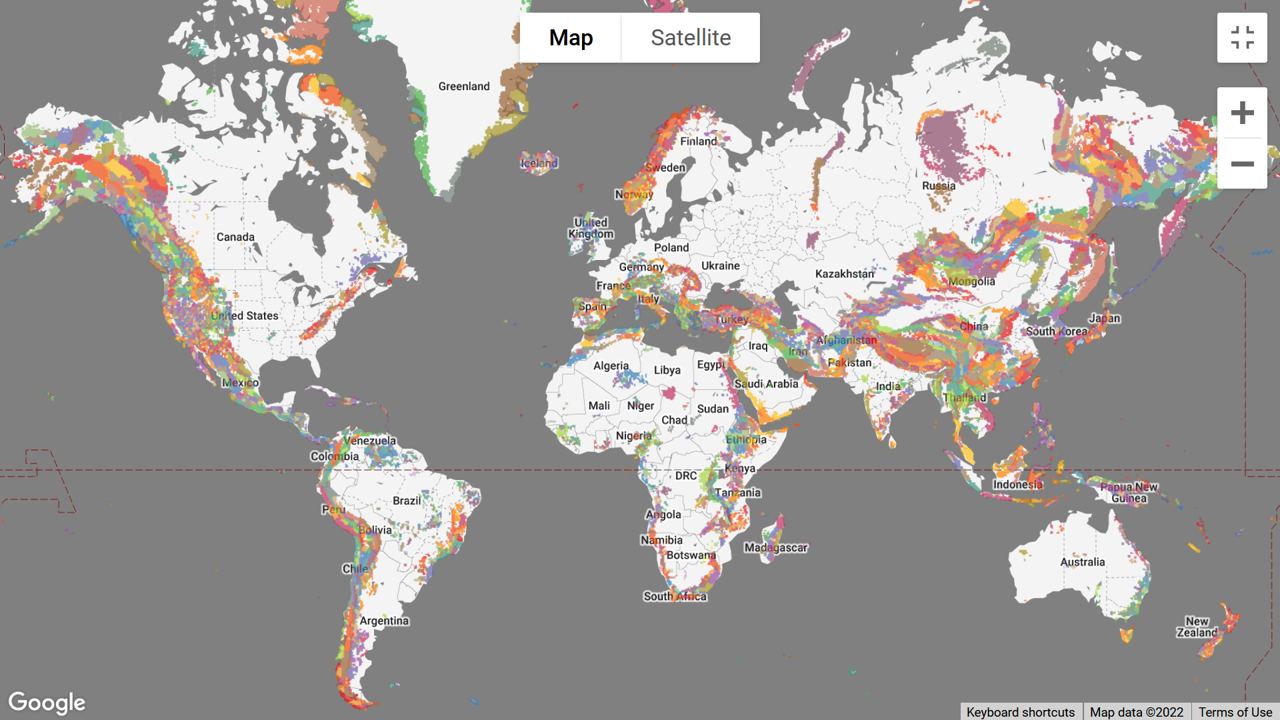A hierarchical inventory of the world’s mountains for global comparative mountain science

ACCESS the latest version of the GMBA inventory v2 on EarthEnv
This new release, introduces a hierarchical classification of the mountain ranges of the world, which allows for the partitioning of mountain systems into smaller ranges and subranges and enables spatially explicit and comparative mountain research across scales.
Methods
The construction of the mountain range polygons is the result of a semi-automated approach, where rivers form the borders between contiguous mountain ranges and the outer borders of the mountain systems correspond to a new, more generalized mountain definition. Details on the polygon delineation and additional information are available in Snethlage et al. (2022).
Paper citation: Snethlage, M.A., Geschke, J., Spehn, E.M., Ranipeta, A., Yoccoz, N.G., Körner, Ch., Jetz, W., Fischer, M. & Urbach, D. (2022). A hierarchical inventory of the world’s mountains for global comparative mountain science. Nature Scientific Data. https://doi.org/10.1038/s41597-022-01256-yDataset citation: Snethlage, M.A., Geschke, J., Spehn, E.M., Ranipeta, A., Yoccoz, N.G., Körner, Ch., Jetz, W., Fischer, M. & Urbach, D. (2022) GMBA Mountain Inventory v2. GMBA-EarthEnv. https://doi.org/10.48601/earthenv-t9k2-1407
Citations 2022
- Du et al. (2022). Recent seasonal spatiotemporal variations in alpine glacier surface elevation in the Pamir. Remote Sensing 14(19), 4923(DOI: 10.3390/rs14194923)
- Hora et al. (2022). Unraveling the differences in landcover patterns in high mountains and low mountain environments within the valdivian temperate rainforest biome in Chile. Land 11(12), 2264 (DOI: 10.3390/land11122264)
- Thornton et al. (2022). Human populations in the world's mountains: spatio-temporal patterns and potential controls. PlosOne 17(7) (DOI: 10.1371/journal.pone.0271466)
- Thornton et al. (2022). Coverage of in situ climatological observations in the world's mountains. Frontiers in Climate (DOI: 10.3389/fclim.2022.814181)
- Zhao et al. (2022). Spatiotemporal patterns and driving factors of ecological vulnerability on the Qinghai-Tibet plateau based on the Google Earth Engine. Remote Sensing 14(20): 5279 (DOI: 10.3390/rs14205279)
- Yousefi et al. (2022). Diversity, diversification and distribution of Iranian vertebrates: the legacy of mountains uplifting, past climatic oscillations, sea level fluctuations and geographical barriers. Biodiversity and Conservation (DOI: 10.1007/s10531-022-02499-2)
Citations 2023
- Dumlupinar et al. (2023). Distributional ecology of Noccaea vesicaria in relation to the Anatolian Diagonal. Turkish Journal of Botany 47(4): 267-277 (DOI: 10.55730/1300-008X.2765)
- Chen et al. (2023). Topographic correction of optical remote sensing images in mountainous areas: a systematic review. IEEE Geoscience and Remote Sensing Magazine 11(4): 125-145 (DOI: 10.1109/MGRS.2023.3311100)
- Fang et al. (2023). Spatiotemporal snow water storage uncertainty in the midlatitude American Cordillera. Cryosphere 17(12): 5175-5195 (DOI:10.5194/tc-17-5175-2023)
- Garbarino et al. (2023). Treeline remote sensing: from tracking treeline shifts to multi-dimensional monitoring of ecotonal change. Remote Sensing in Ecology and Evolution (DOI: 10.1002/rse2.351)
- Gomez-Diaz et al. (2023). Diversity patterns of vascular plant groups along gradients of elevation and disturbance in Mexico. In: Myster, R.W. (eds) Neotropical Gradients and Their Analysis. Springer, Cham, p. 391-418. (DOI: 10.1007/978-3-031-22848-3_14)
- Knight and Harrison (2023). The sensitivity and evolutionary trajectory of the mountain cryosphere: implications for mountain geomorphic systems and hazards. Land Degradation and Development (DOI: 10.1002/ldr.4630)
- Ly et al. (2023). Subnational biodiversity reporting metrics for mountain ecosystems. Nature Sustainability (DOI: 10.1038/s41893-023-01232-3)
- Pinkert et al. (2023). The potential of ecoregional range maps for boosting taxonomic coverage in ecology and conservation. Ecography(DOI: 10.1111/ecog.06794)
- Rono et al. (2023). An annotated plant checklist of the transboundary volcanic Mt Elgon, East Africa. PhytoKeys (DOI: 10.3897/phytokeys.223.97401)
- Sahana et al. (2023). Assessing high conservation value areas for rare, endemic and threatened (RET) species: a study in high altitude Changthang Landscape of India. Journal of Nature Conservation 126406 (DOI: 10.1016/j.jnc.2023.126406)
- Sarmiento et al. (2023). La Montología Global 4D: Hacia las Ciencias Convergentes y Transdisciplinarias de Montaña a través del Tiempo y el Espacio. Pirineos 178: e075 (DOI: 10.3989/pirineos.2023.178001)
- Urbach et al. (2023). Mountain biodiversity under change. In Safeguarding Mountain Social-Ecological, S. Schneiderbauer, P. Fontanella Pisa, J. Szarzynski, Eds. (DOI: 10.1016/B978-0-12-822095-5.00002-4)
- Verrall (2023). Assessing alpine vegetation dynamics using long-term ecological monitoring amidst rapid climate change. PhD thesis.
- Zhang et al. (2023). Kinematic inventory of rock glaciers in the Nyainqêntanglha Range using the MT-InSAR method. International Journal of Digital Earth 16(1) (DOI: 17538947.2023.2260778)
- Zou et al. (2023). Assessing the upper elevational limits of vegetation growth in global high-mountains. Remote Sensing of Environment 286:113423 (DOI: 10.1016/j.rse.2022.113423)
- Yousefi et al. (2023). Modeling global habitat suitability and environmental predictor of distribution of a Near Threatened avian scavenger at a high spatial resolution. Frontiers in Ecology and Evolution 11 (DOI: 10.3389/fevo.2023.1112962)
Citations 2024
- Carrivick et al. (2024). Accelerating glacier area loss across the Andes since the Little Ice Age. Geophysical Research Letters 51(13): e2024GL109154(DOI: 10.1029/2024GL109154)
- Chaon et al. (2024). Climate velocities and species tracking in global mountain regions. Nature (DOI: 10.1038/s41586-024-07264-9)
- Gao et al. (2024). Shifts of forest resilience after seismic disturbances in tectonically active regions. Nature Geoscience (DOI: 10.1038/s41561-024-01380-x)
- Lopez-Reyez et al. (2024). Exploring the causes underlying the latitudinal variation in range sizes: Evidence for Rapoport’s rule in spiny lizards (genus Sceloporus). PlosOne (DOI: 10.1371/journal.pone.0306832)
- Ma et al. (2024). Most high mountainous areas around the world present elevation-dependent aridification after the 1970s. Earth's Future 12:5, e2023EF003936 (DOI: 10.1029/2023EF00393610.5194/egusphere-2023-3014)
- Mudryk et al. (preprint). Benchmarking of SWE products based on outcomes of the SnowPEx+ Intercomparison Project. EGU Sphere (DOI: 10.5194/egusphere-2023-3014)
- Theobald et al. (2024). Evaluating ecosystem protection and fragmentation of the world's major mountain regions. Conservation Biology(DOI: 10.1111/cobi.14240)
